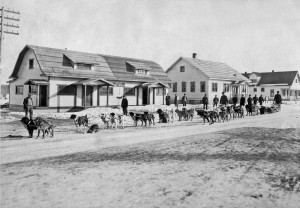In 1914 Anchorage was born. For projects contributing to our city’s yearlong centennial celebration, $500,000 in grant money is available We are applying for a grant to replicate two historic dog sleds used a century ago to carry mail, passengers, and freight in and out of Anchorage over the Iditarod Trail.
Alaskans take pride in our state’s renown as “The Last Frontier.” As a symbol of yesteryear’s Alaska, ranking right up there with the romantic picture of the venerable sourdough prospector with his gold pan is the equally romantic image of the old-time musher and laden sled pulled by the wondrous sled dogs of the North. The husky was as indispensable to the discovery, settling, and development of our northern frontier as was the horse to the winning of the West. And in Alaska, among residents and visitors alike, romance of the gold rush era is a psychological draw that plays powerfully on the senses.
In the first decades of the twentieth century, across Alaska a system of thousands of miles of dog team trails connected Alaskans to one another and the industrialized world outside. Although it was, in essence, a Stone Age means of transport, it was perfectly suited for the harsh, primitive conditions of the Old North of the gold rush era.
The years just prior to and during the founding of Anchorage coincided with the big years of the Iditarod Gold Strike. At the building of the Iditarod Trail in 1910-1911, the main route between Seward and Iditarod went over the Indian Creek-Ship Creek Pass, paralleling, and not that far in back of our present east edge of town. And was that traffic ever heavy! In just the month of November, 1911 alone, 120 teams and a great number of foot travelers went through Knik bound northwest for Iditarod. Many, if not almost all, had passed through our area on their way from Seward.
In 1914 Alaska Railroad builders arrived on Upper Cook Inlet to replace part of that old system with the most modern upgrade the Industrial Age had to offer. Once in place, the new system would be able to move thousands of times more volume tens of times faster than the old. But it would take until 1917 for the laying of steel to progress to where steam power over the rails was ready to take over from dog power over the Iditarod Trail. So in Anchorage’s founding years, from 1914 to 1917 the trail remained as vital as ever. It was all they had for travel in and out, transport of freight, and communication.
To put the dog teams’ importance to early Anchorage into perspective, imagine today’s Anchorage trying to get by for five months yearly without the Glenn and Seward Highways, Alaska Railroad, International Airport and Merrill Field, without the telephone, internet, radio, television, and print media. That paints a pretty close-to-home picture of how crimped railroad construction and the town’s founding would have been one hundred years ago without the dog team.

